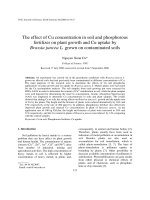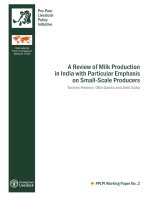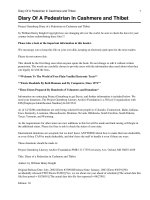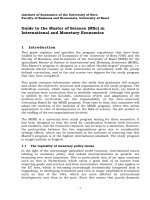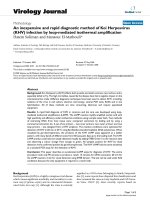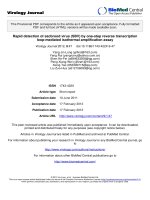Evaluation of loop mediated isothermal DNA aplification (LAMP) detection of salmonella spp in foods and listeria monocytogenes on environmental surfaces
Bạn đang xem bản rút gọn của tài liệu. Xem và tải ngay bản đầy đủ của tài liệu tại đây (1.08 MB, 82 trang )
Evaluation of Loop Mediated Isothermal DNA Amplification
(LAMP) on Detection of Salmonella spp. in Foods and Listeria
monocytogenes on Environmental Surfaces
Hazel Lim Sin Yue
(BSc. Biomedical Science, Curtin University of Australia)
A THESIS SUBMITTED
FOR THE DEGREE OF MASTER OF SCIENCE (RESEARCH)
FOOD SCIENCE & TECHNOLOGY PROGRAMME
DEPARTMENT OF CHEMISTRY
NATIONAL UNIVERSITY OF SINGAPORE
2014
THESIS DECLARATION
I hereby declare that this thesis is my original work and it has been written by
me in its entirety, under the supervision of Assistant Professor Yuk HyunGyun (in the laboratory S14-05-04a), Food Science and Technology
Programme, c/o Department of Chemistry, National University of Singapore
between January 2013 and August 2014.
I have duly acknowledged all the sources of information which have been used
in this thesis.
This thesis has also not been submitted for any degree in any university
previously.
___________________
Name
___________________
Signature
___________________
Date
i
ACKNOWLEDGEMENTS
First and foremost, I would like to extend my sincere gratitude to my
supervisor, Dr Yuk Hyun-Gyun for his acceptance of me to be part of his
research team, hence granting my childhood dream to study in NUS. I would
like to thank him for his supervision, guidance and patience during my research
along with his many words of encouragement. His openness to give
constructive, critical comments aids me to think deeper and more extensively on
how to improve and enhance my research work. I am also highly grateful to Dr
Miks-Krajnik, Marta Hanna for her sound advice and suggestion in all areas of
my research work, most importantly is her faith in me that I can complete the
research project.
I would also like to thank the faculty and staff of Food Science and
Technology Programme including Mdm Lee Chooi Lan, Ms Lee Huey Lee, Ms
Jiang Xiao Hui and Mr Abdul Rahaman Bin Mohd Noor for their kind
assistance and support.
Also, my great thanks to all my fellow lab mates, QianWang, Yishan,
MinJeong, Vinayak and Amit, for their kind words and supports. I would also
like to thank internship students from Korea So –Yeon and FST 1st year student,
Zhi Hwa for their great assistance and contribution in this research work. It was
such an honor to work with such fine students who are smart yet humble. Next,
I would also like to extend my thanks to the Matt Turner and Norman Kok from
3M Food Safety for their strong support in this research work.
ii
Last but not the least; I would like to give my whole hearted thanks to
my family who has been extremely tolerant and patient during this period of my
frequent absenteeism at home. Lucas, Skyler and Ethan are my greatest
motivation to complete this research work , thereby I would like to dedicate this
thesis to my three lovable boys who missed their mother during this time due to
the commitment to finishing this research work the soonest to be with them.
iii
TABLE OF CONTENTS
THESIS DECLARATION.................................................................................. i
ACKNOWLEDGEMENTS ...............................................................................ii
TABLE OF CONTENTS .................................................................................. iv
SUMMARY ...................................................................................................... vi
LIST OF TABLES ......................................................................................... viii
LIST OF FIGURES .......................................................................................... ix
CHAPTER 1 ...................................................................................................... 1
INTRODUCTION ............................................................................................. 1
CHAPTER 2 ...................................................................................................... 5
LITERATURE REVIEW .................................................................................. 5
2.1 Salmonella spp. ............................................................................................ 5
2.1.1 Bacteriology .......................................................................................... 5
2.1.2 Sources and transmission ...................................................................... 5
2.1.3 Outbreaks associated with Salmonella spp. .......................................... 6
2.2 Listeria monocytogenes ............................................................................. 10
2.2.1 Bacteriology ........................................................................................ 10
2.2.2 Adaptability ......................................................................................... 10
2.2.3 Sources and transmission .................................................................... 11
2.2.4 Outbreaks associated with Listeria monocytogenes ............................ 11
2.3 Nucleic acid based sequence amplification (NASBA) for the detection of
foodborne pathogens ........................................................................................ 14
2.3.1 Real-time polymerase chain reaction .................................................. 14
2.3.2 Loop-mediated isothermal amplification ............................................ 14
2.3.3 Loop-mediated isothermal amplification with bioluminescence ........ 17
2.3.4 Limitation of PCR based detection methods in food safety ................ 18
2.3.5 Performance characteristics in selections of rapid methods................ 20
iv
CHAPTER 3 .................................................................................................... 22
COMPARISON OF 3M™ MOLECULAR DETECTION ASSAY (MDA)
SALMONELLA WITH STANDARD ISO METHOD FOR RAPID
DETECTION OF SALMONELLA SPP ON RAW DUCK WINGS, RAW
MUNG BEAN SPROUTS AND PROCESSED FISHBALLS ....................... 22
3.1 Introduction ................................................................................................ 22
3.2 Materials and Methods ............................................................................... 24
3.2.1 Bacterial cultures and preparation of inoculum .................................. 24
3.2.2 Preparation of heat- and sanitizer-injured cells. .................................. 25
3.2.3 Inoculation of Salmonella cells on food samples ................................ 26
3.2.4 Standard culture method...................................................................... 27
3.2.5 3M™ molecular detection assay (MDA) Salmonella ......................... 28
3.2.6 Statistical analysis ............................................................................... 29
3.3 Results and Discussion .............................................................................. 30
3.4 Conclusion ................................................................................................. 39
CHAPTER 4 .................................................................................................... 40
COMPARISON OF 3M™ MOLECULAR DETECTION ASSAY (MDA)
LISTERIA.MONOCYTOGENES WITH ISO STANDARD METHOD FOR
RAPID DETECTION OF L.MONOCYTOGENES ARTIFICALLY
INOCULATED ON ENVIRONMENTAL SURFACES WITH NO
ORGANIC LOAD AND ORGANIC LOAD .................................................. 40
4.1 Introduction ................................................................................................ 40
4.2 Materials and methods ............................................................................... 42
4.2.1 Bacterial culture .................................................................................. 42
4.2.2 Preparation of food contact surfaces ................................................... 42
4.2.3 Recovery of L. monocytogenes from the surfaces............................... 43
4.2.4 Inoculation on test surfaces ................................................................. 43
4.2.5 Standard culture method...................................................................... 44
4.2.6 3M™ molecular detection assay (MDA) Listeria monocytogenes ..... 44
4.2.7 Statistical Analysis .............................................................................. 45
4.3 Results and Discussion .............................................................................. 45
4.4 Conclusion ................................................................................................. 50
CHAPTER 5 .................................................................................................... 52
OVERALL CONCLUSIONS AND FUTURE STUDY ................................. 52
BIBLIOGRAPHY ............................................................................................ 54
v
SUMMARY
Salmonella spp. and Listeria monocytogenes are listed in top five
pathogens contributing to domestically acquired foodborne illnesses resulting
in death according to Centre for Disease Control (CDC). Food is an excellent
vehicle of transmission for pathogens to grow and make consumers sick.
Hence, monitoring of contamination in the food is crucial. Advances in
detection methods of pathogens in foods and environmental samples using
molecular detection improve response time to prevent food contaminated with
pathogens reaching consumers.
A simple and cost effective novel detection method combining loop
mediated
isothermal
DNA
amplification
(LAMP)
method
with
bioluminescence named as 3M™ molecular detection system (MDS) has
recently been developed. 3M™ molecular detection assay (MDA) is used with
the 3M™ MDS for qualitative analysis of pathogens in foods and
environmental samples the next day after enrichment. Hence, testing time is
much reduced in comparison to ISO methods that typically require 5 – 7 days.
In this study, the comparison of 3M™ MDA to standard ISO methods
on Salmonella spp. and Listeria monocytogenes were performed to determine
the sensitivity and specificity at various inoculum levels. For the first study, a
healthy Salmonella cocktail was inoculated on raw duck wings, raw bean
sprouts and processed fish balls to achieve two inoculation levels: 100 and 101
CFU/25g. To simulate real food processing scenario, a Salmonella cocktail
culture was subjected to heat and sanitizer processes to achieve 80% - 85%
sub-lethal heat and sanitizer injury, respectively, followed by inoculation on
vi
food matrices. Validation on the naturally contaminated food matrices was
conducted as well.
The second study was the detection of L. monocytogenes on
environmental surfaces at 3 inoculum levels: 100, 101 and 102 CFU/100 cm2.
Often, food preparation surfaces are contaminated with food likely due to poor
hygiene hence it is of interest to determine whether the presence of organic
load affects the viability of Listeria monocytogenes on stainless steel (SS) and
polyethylene (PE) surfaces.
It is evident from the first study; time to result for rapid pathogen
detection methods is generally shorter due to more sophisticated technology
and also shorter enrichment time. This shorter enrichment time may result in
level of target pathogens not reaching the limit of detection level due to the
low numbers of target pathogens present, the presence of background
microflora competing for nutrients or insufficient time for injured target
pathogens to grow to detectable level. Hence, it is important to have optimized
enrichment protocol for food sample of high background microflora. Other
optimization methods to be considered could be increasing the sample volume
or increase the sample concentration via centrifugation.
Other than testing for pathogens in food matrices, it is also important
for food manufacturers to choose materials of construction that do not support
cell viability in food processing plants and to maintain plant hygiene at all
times to minimize cross contamination due to contact or handling.
vii
LIST OF TABLES
Table 1. Summary of foodborne outbreaks associated with Salmonella spp. in
US from 2006 to 2013
Table 2. Summary of foodborne outbreaks associated with Salmonella spp. in
Singapore from 2002 to 2011
Table 3. Summary of foodborne outbreaks associated with Listeria
monocytogenes in US from 200 to 2013
Table 4. Comparison of 3M™ MDA Salmonella and ISO methods on the
detection of healthy and sub-lethally injured Salmonella spp. inoculated on
raw duck wings, raw mung bean sprouts and processed fishballs at an
inoculum level of 101 CFU/25 g.
Table 5. Comparison of 3M™ MDA Salmonella and ISO methods on the
detection of healthy and sub-lethally injured Salmonella spp. inoculated on
raw duck wings, raw mung bean sprouts and processed fishballs at an
inoculum level of 100 CFU/25 g.
Table 6. Validation of 3M™ MDA Salmonella for the detection of Salmonella
spp. on naturally contaminated raw duck wings, raw mung bean sprouts and
processed fishballs.
Table 7. Comparison of 3M™ MDA Listeria monocytogenes and ISO
methods on detection of inoculated Listeria monocytogenes at inoculum levels
of 100, 101 and 102 CFU/100 cm2 on stainless steel and polyethylene with no
organic load and with organic load.
viii
LIST OF FIGURES
Figure 1. Schematic diagram of loop-mediated isothermal amplification
(LAMP).
Figure 2. Principle of loop mediated isothermal DNA amplification (LAMP)
reaction with bioluminescence pathway.
Figure 3. The experimental design of 3MTM molecular detection assay (MDA)
Salmonella comparison with standard ISO methods for the detection of
healthy and sub-lethally injured Salmonella spp. inoculated at levels of 100 and
101 CFU/25 g on different food matrices. BPW, buffered peptone water, RVS,
Rappaport–Vassiliadis medium with soya broth, MKTTn, Muller–Kauffmann
tetrathionate –novobiocin broth, XLD, xylose lysine deoxycholate agar, HE,
Hektoen Enteric agar, NA, nutrient agar.
ix
CHAPTER 1
INTRODUCTION
Food safety is the global goal of food producers and food industry at
large as food is consumed daily, from the young to elderly, whereby these two
groups are the most vulnerable to foods contaminated with pathogens due to
weak immunity (Kärkkäinen et al., 2011; Kothary and Babu 2001). As such,
many countries have adopted a zero tolerance policy regarding the presence of
foodborne pathogens such as Salmonella spp. and Listeria monocytogenes in
foods.
To ensure microbiological food safety, a wide range of pathogen
intervention strategies along with control measures such as Good Agricultural
Practices (GAP), Good Manufacturing Practices (GMP) and Hazard Analysis
and Critical Control Point (HACCP) are in place to minimize opportunities for
the introduction, persistence, and transmission of pathogenic microorganisms
during farm to fork process (Velusamy et al., 2010; Doyle and Erickson,
2012).
Despite such effort, foodborne illnesses by consumption of foods
contaminated with pathogens are still relatively common even in developed
countries like the United States (US) and Singapore. In 2012, Communicable
Disease Surveillance in Singapore reported 1,499 laboratory confirmed
salmonellosis cases (MOH, 2012). In 2011, Center for Disease Control and
Prevention (CDC) in US reported that known pathogens caused an estimated
1
9.4 million cases of foodborne illness, 55,961 hospitalizations and 1351 deaths
in United States (CDC, 2011d). Likely factors are trading of contaminated
foods between countries/states which increases the likelihood of outbreak and
illness coupled with changes in lifestyle and consumer demands such as
increasing consumption of fresh vegetables and frequent outdoor dining
(Rocourt, 2003). Among foodborne pathogens, nontyphoidal Salmonella spp.
and L. monocytogenes were responsible for 47% of the reported deaths in
2011 (CDC, 2011). These alarming reported data support the fact that failure
to detect foodborne pathogens would lead to a dreadful effect.
Despite national monitoring and surveillance programs, reasons for
failure to detect pathogens in foods could be due to the presence of low
numbers of pathogens, food composites such as fats and phenolic compound
that could inhibit detection methods, and injured cells that were not given
enough time to resuscitate to be detected (Dwivedi et al., 2014). This is a valid
concern since selective media contain agents such as antibiotics that were
designed to select for healthy target microorganisms and the presence of these
agents could lead to extended lag phases in injured target microorganisms.
During the food process, treatments such as heating, freezing and sanitizing to
microbial population cause dead, uninjured (healthy cells) or injured cells (Wu
and Fung, 2001). Injured cells are as important as the healthy cells as they can
resuscitate and become healthy again in favorable conditions, resulting in
foodborne outbreak (Wu, 2008).
Conventional culture methods for the detection and identification of
foodborne pathogens are laborious, time consuming and slow to obtain results.
2
These methods depend on several steps including enrichment, selective plates
and biochemical confirmation that require long time for microbial pathogens
to grow to react (Lee et al., 2015). Nevertheless, such methods are inexpensive
and sensitive which explains why many food laboratories are still following
such methods.
To overcome these drawbacks of conventional culture methods, rapid
immunological
or
molecular-based
assays
such
as
enzyme-linked
immunosorbent assay (ELISA), polymerase chain reaction (PCR) (Dwivedi
and Jaykus, 2011) and loop mediated isothermal DNA amplification method
(LAMP) have been developed. ELISA relies on the specific binding of an
antibody to an antigen and is designed as sandwiched assay with detection
limits from 103 to 105 CFU/ml (Mandal et al., 2011), while PCR is an in vitro
method that amplified specific DNA fragments with the cyclic 3-step process
namely denaturation, annealing and extension (Cornett et al., 2001). With
advances in PCR, real-time quantitative PCR (qPCR) has been developed to
monitor the progress of reactions as it occurs in real time. LAMP, a newly
developed method, uses multiple primers to recognize distinct regions of the
genome (invA) with amplification taking place by auto-cycling strand
displacement DNA synthesis in the presence of Bst DNA polymerase under
isothermal conditions at 60°C (Wang et al., 2008).
Recently, a user-friendly rapid detection system using LAMP coupled
with bioluminescence named as 3M™ molecular detection system (3MTM
MDS) has been commercialized. LAMP is known for its specificity and ability
to handle more complex samples while bioluminescence is predominantly
3
used in hygiene monitoring (Murphy et al., 1998). 3M™ Molecular Detection
Assay (MDA) is used with 3M™ MDS for qualitative analysis of pathogens in
samples the next day after enrichment (Bird et al., 2013). This is the first
commercially available assay of its kind that combines these two technologies.
Studies have been performed on this system with various foods in USA and
Europe. However, limited testing has been studied with foods in Southeast
Asia. Hence, it would be of interest to conduct a comprehensive study of
artificially inoculated foodborne pathogens at different inoculum levels on
local food matrices in Southeast Asia along with surfaces commonly used at
food processing facilities.
Therefore, the objective of this study was to evaluate the performance
of 3M™ MDA to ISO standard methods for the detection of Salmonella spp.
on raw duck wings, raw mung bean sprouts and processed fishballs at low
inoculum levels of 100 and 101 CFU/25g, respectively. In addition, the
performance of 3M™ MDA on the detection of thermally- or sanitizer-injured
Salmonella spp. in each food matrix was also conducted. For the application
on environmental samples, 3M™ MDA was evaluated for the detection of L.
monocyotogenes artificially inoculated at 3 inoculum levels of 100 ,101 and 102
CFU/100 cm2 on two food contact surfaces: stainless steel and polyethylene
with or without organic load.
4
CHAPTER 2
LITERATURE REVIEW
2.1 Salmonella spp.
2.1.1 Bacteriology
Salmonella spp. is Gram-negative, motile, rod-shaped bacteria that can
grow both aerobically and anaerobically belonging to the family
Enterobacteriaceae (Baird-Parker, 1990). They are catalase positive, oxidase
negative, and generally produces hydrogen sulfide. Salmonella spp. can utilize
citrate as a sole carbon source and can decarboxylate lysine.
2.1.2 Sources and transmission
Salmonella spp. is able to colonize a wide range of hosts and all the
major livestock species (poultry, cattle, and pigs) and are often
asymptomatically (Newell et al., 2010). During the transportation to slaughter
houses, Salmonella cells are readily transferred to carcasses through fecal
contamination. Further spread of cells may occur during processing if
carcasses become cross-contaminated (Carrasco et al., 2012).
Fresh produce grown in developing countries where manures from
these infected animals are frequently used as natural fertilizers introduce
pathogens directly to the field, and run-off can contaminate irrigation water
(Heaton and Jones, 2008). For irrigation use, wastewater should receive
5
treatment, but in lower-income countries, raw sewage is often used directly
(WWDR, 2003).
Handling processes from storage and rinsing to cutting are also
possible sources of contamination. Experimental work has demonstrated
clearly that passing a knife through a contaminated surface inoculates the
newly exposed surfaces and allows pathogen to grow (Lin and Wei, 1997).
Insects are another possible source as contaminated files have been shown to
be a potential vector of Salmonella spp. to fruits (Sela et al., 2005).
2.1.3 Outbreaks associated with Salmonella spp.
Fresh vegetables are part of a healthy balanced diet and are generally
consumed as raw like salad or side dishes. However, fresh produce could be
contaminated during pre- or post-harvesting and becomes vehicles for
transmission of Salmonella spp. (Guo et al., 2002).
Many studies have shown that outbreaks associated with raw sprouts
are originated from contaminated seeds (Mahon et al., 1997). Sprout seeds
could be contaminated via contact with pests such as rodents during storage or
shipping or on the farms via animal feces (Taormina et al., 1999). Salmonella
spp. can survive for months on seeds, along with a lack of microbiological
control steps. Moreover, sprouting processes under high humidity and
moderate temperature conditions may allow cells of low concentrations on
seeds to proliferate to high levels (Erdozain et al., 2013). In response to this
lack of control , US Food and Drug Administration (FDA) issued a guideline
named ―Reducing Microbial Food Safety Hazards for Sprouted Seeds‖ for
industry in 1999 to minimize pathogen contamination in sprouts (FDA, 1999).
Despite the guidelines entailing the need for pathogen testing, the FDA
6
inspection report stated that farm microbiological testing was not adequate to
monitor pathogen contamination (FDA, 2010).
Poultry are a known reservoir of Salmonella spp. and the risk of
salmonellosis after contact with live poultry, especially chicks and ducklings,
has been verified by stated outbreaks in Table 1. Since most outbreaks are
associated with purchase and/or contact with live poultry in agricultural feed
stores, agricultural feed stores should provide handwashing facilities and
information on salmonellosis to persons considering a live poultry purchase.
In Singapore, the documented foodborne outbreaks related to
Salmonella spp. were due to the presence of eggs as the main ingredient for
two reported cases and the other two cases were pre-prepared foods.
Consumption of eggs are a frequent cause since eggs is a major source of S.
Enteritidis. One study reported that when identifying the vehicle of
transmission in Salmonella outbreak, 77% were caused by food that contained
eggs or by eggs alone and were likely to be inadequately cooked (Louis et al.,
1988). For the reported prepared meals, the kitchen was found to be dirty and
poor hygiene of food handlers was observed. Food handlers were tested
positive for S. Enteritidis and a high standard plate count was reported from
food trays. In addition, it was observed that the same food trays and food
scoops were used across raw and cooked foods resulting in cross
contamination. As for foods prepared by caterers, the absence of soap on the
premises and handling of food by the handlers without hand gloves were
reported.
With effect from 15 Feb 2012, National Environment Agency (NEA)
in Singapore had a mandatory requirement to have a time stamp on packed
7
foods and catering foods. The time stamp includes the time and date the food
is cooked and when it should be ―CONSUMED BY‖ time not more than 4
hours from the food is cooked (NEA, 2013). Foodborne outbreaks in
Singapore associated with Salmonella spp. are summarized in Table 2.
Table 1. Summary of food borne outbreaks associated with Salmonella spp. in
US from 2006 to 2013
Food Type
Food borne
Pathogens
Salmonella
Typhimurium
Year
Nov
2006
183
22
CDC,
2006
Sprouts, Tiny
Greens
Organic Farm
Salmonella
serotype I
4,[5],12:i
Nov
2010
140
34
CDC,
2010
Chicks and
Duckling
Salmonella
Altona
Oct
2011
68
19
CDC,
2011b
Raw Scraped
Ground Tuna
Product
Salmonella
Bareilly,
Salmonella
Nchanga
Jan
2012
425
55
CDC,
2012a
Foster Farms
Brand Chicken
Salmonella
Heidelberg
Mar
2013
574
212
CDC,
2013c
Live Poultry in
Backyard
Flocks
Salmonella
Typhimurium
Nov
2013
356
62
CDC,
2013a
Tomatoes
No of cases Hospitalization
Reference
8
Table 2 .Summary of food borne outbreaks associated with Salmonella spp. in
Singapore from 2002 to 2011
Food
Type
Fried Egg
Omelette
Foodborne
pathogens
Clinical and
epidemiological data
suggestive of
Salmonella spp.
Year
No of
cases
32
Hospitalization
0
MOH,
2002
Prepared
Meals
Handler tested
positive for S.
Enteritidis and
Salmonella spp.
May
2006
77
0
MOH,
2006
Food
Caterer
Likely to be of
bacterial nature
such as
Salmonella spp.
Mar
2007
68
49
MOH,
2007
Omelette
Floss
Bread
S. Enteritidis
Sep
2011
14
4
MOH,
2011
Nov
2002
Reference
9
2.2 Listeria monocytogenes
2.2.1 Bacteriology
Listeria monocytogenes are non-sporeforming, Gram-positive rods and
facultative anaerobe. They are catalase positive, oxidase negative and secrete
beta haemolysin that produces clear zones on a sheep plate with
Staphylococcus aureus termed as Christie, Atkins, and Munch-Peterson
(CAMP) test (Farber and Peterkin, 1991). L. monocytogenes can utilize
glucose, lactose and rhamnose, and cannot utilize xylose under the aerobic
condition, hence rhamnose and xylose serves as a key test to differentiate L.
monocytogenes from other Listeria spp. (Gasanov et al., 2005).
2.2.2 Adaptability
L. monocytogenes are slow growing and can be rapidly out-grown by
competitors; however, they are also adaptable to harsh conditions compared to
their competitors, which explains the difficulty in controlling their presence in
foods and environments (Duché et al., 2002). This pathogen is a psychrotophic
bacterium that is able to grow at 4°C. When present in low numbers, they can
grow to considerable numbers to make consumers sick upon eating
refrigerated ―ready-to-eat-food‖ such as packed smoked salmon (Rørvik et al.,
1991). Studies have shown an increased expression of bacterial cold shock
proteins (Csps) in response to reduced temperatures (Wouters et al., 2000).
This pathogen also has the ability to grow in high salt concentrations, which is
a common food preservative in smoked salmon.
10
2.2.3 Sources and transmission
Some
food
types
are
closely linked
to
L.
monocytogenes
contamination, namely cheese, poultry and fish. Studies have demonstrated
that L. monocytogenes were typically isolated externally such as the surface of
the cheese rind and meat (Farber and Peterkin 1991; Eklund et al., 1995). This
affirms that in food processing plants, bacterial attachments to food contact
surfaces are significant as the vehicle of transmission (Herald and Zottola
1988). One study concluded that excretion of L. monocytogenes by farm
animals was linked to their diet especially if their diet source was
contaminated with L. monocytogenes such as silage (Skovgaard and Morgen,
1988). Similar to Salmonella spp., when the animal is stressed by situations
such as long hours of travelling, increased excretion of L. monocytogenes
would occur. It is highly likely that contamination takes place on the farm and
this potentially carries the bacterial to the food processing environment to be
become adaptable and eventually established. This act leads to unwanted
contamination of food especially if proper hygiene and testing is not in place
and followed dutifully (Fenlon et. al., 1996).
2.2.4 Outbreaks associated with Listeria monocytogenes
Out of the four food borne outbreaks associated with L.
monocytogenes, three were related to cheese products and one was fresh
produce as summarized in Table 3. Investigation report stated that pasteurized
milk was used in cheese. Although it had been perceived that pasteurized milk
would be safer than raw milk, however, there had been studies with findings
that stated more L. monocytogenes positive cheeses were made from
pasteurized milk (8%) compared to the raw milk cheeses (4.8%) (Rudolf and
11
Scherer, 2001). Investigation report also states that other cheeses associated
with products manufactured in the affected food company together with
environmental samples harbored L. monocytogenes.
Cross contamination from food contact surfaces is likely to cause
listeriosis as well. One study concluded that normal pasteurization of milk
would prevent contamination of cheeses with L. monocytogenes, provided that
recontamination during production is prevented (Beckers et al., 1987).
Detached L. monocytogenes cells from soiled surfaces may contaminate foods
and proliferate under refrigeration (Poimenidou et al., 2009).
The
external
epidermal
layer
of
fruits
protects
it
against
microorganisms; once this barrier is broken by actions such as slicing; the
internal of the fruit can be contaminated, which allows bacterial growth
(Penteado and Leitão, 2004). As such, it is an industrial practice for the
produce to be subjected to sanitizer treatments in order to reduce the microbial
load. A reported study on inoculation of high levels of L. monocytogenes on
the external of fresh produce had at least five log reductions after sanitizer
treatments. Subsequently, fresh produce was stored in the cold for nine days
and L. monocytogenes was successfully isolated from treated samples. This
finding indicated that sanitizer treatments could only diminish the level of
contamination but did not totally eliminate its presence during storage. In
addition, this study also showed that L. monocytogenes was able to multiply
and grow if there were survivors after sanitizer treatments (Rodgers et al.,
2004). Hence, it is highly likely that the interior of fruits could be
contaminated through improper handling via cutting on cutting board and
knife as it had been in contact with the external surface of the fruit.
12
Recent foodborne outbreaks in US associated with L. monocytogenes
are summarized in Table 3. It should be noted that L. monocytogenes cause
high mortality rates of 27.6% compared to other pathogens, making elderly,
children, immunocompromised people and pregnant woman particularly
vulnerable (Mead et al., 1999).
Table 3.Summary of food borne outbreaks associated with Listeria
monocytogenes in US from 200 to 2013
Food Type
Year
Cheese
(Roos Foods
Dairy)
April
2014
Crave Brothers
Farmstead
Cheese
Sep
2013
Frescolina
Marte Brand
Ricotta Salata
Cheese
Cantaloupe
from Jensen
Farms
No of
cases
8
Hospitalization
Death
Reference
7
1
CDC, 2014
6
6
1
CDC, 2013b
Nov
2012
22
20
4
CDC, 2012b
Sep
2011
145
143
33
CDC, 2011c
13
2.3 Nucleic acid based sequence amplification (NASBA) for the detection
of foodborne pathogens
2.3.1 Real-time polymerase chain reaction
The real time PCR (qPCR) consists of three steps namely i)
denaturation of the double standed DNA whereby two stands of DNA
template are separated from each other at 94°C; ii) temperature is lowered to
55°C to allow annealing of short DNA fragments (primers) to single DNA
stands; (iii) lastly, temperature increases to 72°C that is the optimal
temperature for extension of the primers with a thermostable DNA polymerase
till a double stranded DNA is formed (Scheu et al., 1998; Cornett et al., 2001).
Real-time monitoring on amplification is possible with the presence of
sequence specific fluorescent probes bound to the amplicon (the fragment of
DNA replicated by PCR) and visualized as the amplicons accumulate. A PCR
instrument detects the intensity of the fluorescent signal during each
replication cycle of the PCR (Hanna et al., 2005). The amplification cycle at
which the fluorescence exceeds a defined threshold level that is known as the
threshold cycle (Ct) is a measure of the dye fluorescence generated by the
cleavage of a probe against a fixed baseline threshold (Corless et al., 2000).
2.3.2 Loop-mediated isothermal amplification
Loop-mediated isothermal amplification (LAMP) was developed by a
group of scientists from Tokyo, Japan (Notomi et al., 2000). The motivation
came about to develop this novel method was due to the high cost of precision
thermal cyclers and the complex method for the detection of amplified
products which acts as a hurdle for nucleic acid-based amplification to be
14
widely used and adopted. The LAMP method does not require costly thermal
cyclers and relies on auto cycling strand displacement DNA synthesis that is
performed by a DNA polymerase derived from Bacillus stearothermophilus
(Bst) with high stand displacement activity at optimal temperatures of 6065°C along with a set of two specially designed inner and outer primers
(Notomi et al., 2000). During the initial reaction, all four primers are used, but
later on during the amplification, only the inner primers are used for strand
displacement DNA synthesis (Notomi et al., 2000; Wang et al., 2008). End
amplification products have variously sized structures consisting of alternate
inverted repeats of the target sequence on the same strand in large amounts
(Hara-Kudo et al, 2005). A schematic diagram of LAMP reactions is shown in
Figure 1.
15

